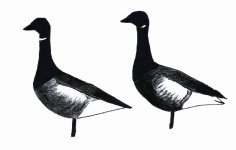Andrew
wibble wibble
Hello all,
Recently a friend and I managed to see a Black Brant at Ferrybridge. We only relaised what it was after it was put out on Birdguides. We have a bit of a debate as whether to include it in our lists. I am all for putting in my list in italics and then reverting it to a full species tick when there is a split if any does occur. My colleague, after discussing it with a birder, argues that all three branta berniclas are simply Brent Geese. I think the same could be said for all Grey Geese if that is the thinking.
With so many potential splits looming in the world of Geese can anyone shed some light on which are likely become full species and count as valid ticks? I understand some are already claiming splits in some geese but not yet the BOU.
Where can an online official list of british species and subspecies be seen? My Google searches' best results are an inaccessible thread on Bird Forum.
Andrew.
Recently a friend and I managed to see a Black Brant at Ferrybridge. We only relaised what it was after it was put out on Birdguides. We have a bit of a debate as whether to include it in our lists. I am all for putting in my list in italics and then reverting it to a full species tick when there is a split if any does occur. My colleague, after discussing it with a birder, argues that all three branta berniclas are simply Brent Geese. I think the same could be said for all Grey Geese if that is the thinking.
With so many potential splits looming in the world of Geese can anyone shed some light on which are likely become full species and count as valid ticks? I understand some are already claiming splits in some geese but not yet the BOU.
Where can an online official list of british species and subspecies be seen? My Google searches' best results are an inaccessible thread on Bird Forum.
Andrew.






